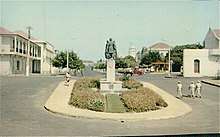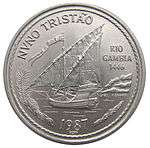Nuno Tristão
Nuno Tristão was a 15th-century Portuguese explorer and slave trader, active in the early 1440s, traditionally thought to be the first European to reach the region of Guinea (legendarily, as far as Guinea-Bissau, but more recent historians believe he did not go beyond the Gambia River).
First voyage
Nuno Tristão was a knight of the household of Henry the Navigator.[1] In 1441, Tristão was dispatched by Henry in one of the first prototypes of the lateen-rigged caravel to explore the West African coast beyond Cape Barbas, the furthest point reached by Henry's last captain five years earlier (Afonso Gonçalves Baldaia, in 1436). Around Rio de Oro, Tristão met up with the ship of Antão Gonçalves, who had been sent on a separate mission by Henry that same year to hunt monk seals that basked on those shores. But Gonçalves happened to capture a solitary young camel-driver, the first native encountered by the Portuguese since the expeditions began in the 1420s. Nuno Tristão, who carried on board one of Henry's Moorish servants to act as an interpreter, interrogated Gonçalves's captive camel-driver. Tristão and Gonçalves were led by his information to a small Sanhaja Berber fishing camp nearby. The Portuguese attacked the fishermen, taking some ten captives, the first African slaves taken by the Portuguese back to Europe. Gonçalves returned to Portugal immediately after the slave raid, but Nuno Tristão continued south, reaching as far as Cape Blanc (Cabo Branco), before turning back.
Second voyage

In 1443, Nuno Tristão was sent out by Henry again, and pressed beyond Cape Blanc to reach the Bay of Arguin. On Arguin island, Tristão encountered a Sanhaja Berber village, the first permanent settlement seen by Henry's captains on the West African coast. Tristão immediately attacked it, taking some fourteen villagers captive and returned to Portugal with his captives. Tristão's report of easy and profitable slave-raiding grounds in the Arguin banks prompted numerous Portuguese merchants and adventurers to apply to Henry for a slave-trading license. Between 1444 and 1446 several dozen Portuguese ships set out for slave raids around Arguin Bay.
Third voyage
As fishing settlements around the Arguin banks were quickly devastated by the Portuguese slave raiders, in 1445 (or possibly 1444), Nuno Tristão was sent by Henry to press further south and look for new slave-raiding grounds. Tristão reached as far south as borderlands of Senegal, where the Sahara desert ends and forest begins, and the coastal population changed from 'tawny' Sanhaja Berbers to 'black' Wolofs. Tristão is believed to have reached as far as the Ponta da Berberia (Langue de Barbarie), just short of the entrance to the Senegal River. Bad weather prevented his entering the river or landing there, so he set sail back. On the way home, Tristão stopped by the Arguin banks and took another 21 Berbers captive.
Nuno Tristão arrived in Portugal declaring he had finally discovered sub-Saharan Africa, or in the nomenclature of the time, the "Land of the Blacks" (Terra dos Guineus, or simply Guinea). Portuguese slave raiders immediately descended on the Senegalese coast, but finding alert and better-armed natives on that coast, the slave raids were not nearly as easy nor as profitable as they had hoped.
Fourth voyage

In 1446 (or perhaps 1445 or 1447, date uncertain), Nuno Tristão set out on his fourth (and final) trip down the West African coast. Somewhere south of Cap Vert, Tristão came across the mouth of a large river. Tristão took 22 sailors with him on a launch upriver, to search for a settlement to raid. But the launch was ambushed by thirteen native canoes with some 80 armed men. Quickly surrounded, Nuno Tristão, along with most of his crew, was killed on the spot by poisoned arrows (two might have escaped).[2] Tristão's caravel, reduced to a crew composed of clerk Aires Tinoco and four grumetes ('ship boys'), immediately set sail back to Portugal. (However, the account of Diogo Gomes differs here; he asserts the caravel never made it back—that the native canoes overpowered and seized it, and then dragged the caravel and dismantled it upriver.)[3]
It is uncertain how far Nuno Tristão actually sailed and where he died. Up until the 1940s, Portuguese tradition asserted Tristão died at Rio do Nuno (Nunez River, modern Guinea), or that he fell just short of it, and died at Rio Grande (Geba River, Guinea-Bissau).[4] As a result, Nuno Tristão was traditionally credited as the 'discoverer' of Portuguese Guinea (modern Guinea-Bissau), and even said to have been the first European to set foot on the landmass of what is now the modern city of Bissau.[5] If true, then Nuno Tristão's last journey was an enormous leap beyond the previous Portuguese milestone (Cabo dos Mastos, Cape Naze, Senegal).
However, modern historians, drawing from larger evidence (including the accounts of Diogo Gomes and Cadamosto), have generally dismissed this claim and now generally agree that Nuno Tristão only reached as far as the Sine-Saloum delta, still in Senegal, just a few miles south of Cape of Masts (Cape Naze) or, at their most generous, the Gambia River. [6] Exactly where has been subject to debate. In his careful investigation, historian Teixeira da Mota concluded that Nuno Tristão first prodded up the Saloum River (Rio de Barbacins, 13°57′47″N 16°45′10″W) then sent his launch up the Diombos River (Rio de Lago, 13°47′57″N 16°36′19″W), the south bank of which was controlled by the Mandinka king known as Niumimansa, of the Niumi Bato. [7] It was these Mandinka (or Mandikized)[8] warriors that ambushed and killed Nuno Tristão. Other scholars attribute the killing of the Portuguese slave raider and his party to the Serer people of Senegambia. This is the general consensus.[9][10]
The death of Nuno Tristão, Henry's favorite captain, was the beginning of the end of this wave of Henry's expeditions. Another set of ships would be still go out the next year, but would also take significant casualties, and as a result, Portuguese expeditions were temporarily suspended. Henry the Navigator did not dispatch another expedition to the West African coast again until a decade later (Cadamosto in 1455).
See also
- History of Portugal (1415–1542)
- Portuguese Empire
Notes
- Barros, p.53; Zurara, p.44
- Zurara (p. 252–57), Barros (p. 118).
- "E tomaram a caravela e levaram-na para dentro do rio e destruiram-na", passage of Diogo Gomes, as reproduced in Teixeira da Mota (1946, Pt. 1, p. 25)
- e.g. Pimentel p.242 asserts it was at Rio Nunez. Barros (p. 118-20), Cortesão (p. 13) assert it was the Geba River. Confusingly, Castilho identifies his death at two different places: Rio Nunez (p. 193) and the Buba River ( p. 185n).
- e.g. Armando Cortesão (1931: p. 12)
- This was first forwarded by João Barreto (1938), Duarte Leite (1941), Damião Peres (1943), Magalhães Godinho (1945) and Teixeira da Mota (1946), and has been generally accepted since.
- Teixeira da Mota (1946, Pt.1,p.59).
- The "Niumi Bato" are probably ancestral to the current Niominka ethnic group living in the islands of the Saloum delta. Although the Niominka are currently classified ethnically as a Serer people, the names are recognizably from the Mandinka language, e.g. the 'Niomi/Niumi' is the Mandinka term for 'coast' and "-Nka" the suffix for "men", so "Niominka" = "men of the coast". As "Mansa" is the Mandinka word for king, so "Niuminansa" is the "king of the Niumi". Old maps distinguish between two groups, the Niumi Bato (ancestral to the modern Niominka people, up near the Diombos river in the Sine-Saloum delta, the likely slayers of Nuno Tristão) and the Niumi Banta (ancestral to the western Mandinka of the "Barra" region at the mouth of the Gambia River). It is believed that at this time, the Niumi Bato, Niumi Banta and Jokadu were all under the same ruler, the Niumimansa. So, if not Mandinka themselves, the Niumi Bato were certainly dominated or acculturated by their powerful Mandinka neighbors to the south or (alternatively) the current Niominka were Serer migrants to the delta that simply took on the appellation of a Mandinka people they found there when they moved to that region four of five centuries ago. See Teixeira da Mota (1946:59, 64-65), Wright (1976).
- Hair, Paul Edward Hedley, "The Use of African Languages in Afro-European contacts in Guinea : 1440–1560", [in] "Sierra Leone Language Review", no. 5, 1966, p. 13
- Hair, Paul Edward Hedley, "Africa encountered: European contacts and evidence, 1450–1700", Variorum, 1997, pp 213-15 & 248, ISBN 0-86078-626-9
References
- João de Barros (1552–59) Décadas da Ásia: Dos feitos, que os Portuguezes fizeram no descubrimento, e conquista, dos mares, e terras do Oriente. Vol. 1 (Dec I, Lib.1-5)
- Gomes Eanes de Zurara (1453) Crónica dos feitos notáveis que se passaram na Conquista da Guiné por mandado do Infante D. Henrique or Chronica do descobrimento e conquista da Guiné. [Trans. 1896–99 by C.R. Beazley and E. Prestage, The Chronicle of the Discovery and Conquest of Guinea, London: Halykut]
- Barreto, João (1938) História da Guiné, 1418–1918. Lisbon.
- Castlereagh, Duncan. Encyclopedia of Discovery and Exploration - The Great Age of Exploration. Aldus Books London, 1971.
- Castilho, A.M. de (1866) Descripção e roteiro da costa occidental de Africa, desde o cabo de Espartel até o das Agulhas, Lisbon: Impresa Nacional, 2 vols.
- Cortesão, Armando (1931) "Subsídios para a história do Descobrimento de Cabo Verde e Guiné", Boletim da Agencia Geral das Colonias, No. 75. As reprinted in 1975, Esparsos, vol. 1, Coimbra
- Leite, Duarte (1941) Acerca da «Crónica dos Feitos de Guinee». Lisbon: Bertrand
- Magalhães Godinho, Vitorino de (1945) Documentos sôbre a Espansão Portuguesa, 2 vols, Lisbon: Gleba.
- Peres, Damião (1943) História dos descobrimentos portugueses, Porto: Portucalense.
- Pimentel, M. (1746) Arte de navegar: em que se ensinam as regras praticas, e os modos de cartear, e de graduar a balestilha por via de numeros, e muitos problemas uteis á navegaçao : e Roteyro das viagens, e costas maritimas de Guiné, Angóla, Brasil, Indias, e Ilhas Occidentaes, e Orientaes. Lisbon: Francisco da Silva
- Teixera da Mota, Avelino (1946) "A descoberta da Guiné", Boletim cultural da Guiné Portuguesa, Vol. 1. Part 1 in No. 1 (Jan), p.11-68, Pt. 2 in No. 2 (Apr), p.273-326; Pt. 3 in No. 3 (Jul), p.457-509.
- Teixeira da Mota, Avelino (1972) Mar, além Mar: Estudos e ensaios de história e geographia. Lisbon: Junta de Investigações do Ultramar